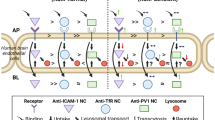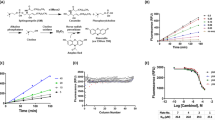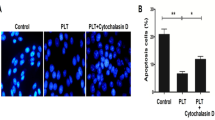Abstract
Shiga toxin (Stx) 1 binds to the glycosphingolipid (GSL) globotriaosylceramide (Gb3Cer/CD77) and injures human endothelial cells. In order to gain insight into Stx1-induced cellular impairment, we analysed in detail the molecular heterogeneity of Stx1 receptors in two endothelial cell lines differing in their Stx1-sensitivity. We observed a moderate sensitivity to Stx1 of human brain microvascular endothelial cells (HBMECs, CD50 > 200 ng/ml), but a considerably higher mortality rate in cultures of EA.hy 926 cells, a cell line derived from human umbilical vein endothelial cells (CD50 of 0.2 ng/ml). Immunofluorescence microscopy demonstrated the presence of Gb3Cer in both cell lines, but showed an enhanced content of Gb3Cer in EA.hy 926 cells. Solid phase overlay binding assays of isolated GSLs combined with nanoelectrospray ionization quadrupole time-of-flight mass spectrometry demonstrated a balanced proportion of Gb3Cer and globotetraosylceramide (Gb4Cer) in HBMECs, but an increase of Gb3Cer and absence of Gb4Cer in EA.hy 926 cells. Gb3Cer species with C24:1/C24:0 fatty acids were found to dominate over those with C16:0 fatty acids in EA.hy 926 cells, but were similarly distributed in HBMECs. Reverse transcriptase polymerase chain reaction indicated the concomitant presence of Gb3Cer and Gb4Cer synthases in HBMECs, whereas EA.hy 926 cells expressed Gb3Cer synthase, but completely lacked Gb4Cer synthase. This deficiency, resulting in the accumulation of Gb3Cer in EA.hy 926 cells, represents the most prominent molecular reason that underlies the different Stx1 sensitivities of HBMECs and EA.hy 926 endothelial cells.







Similar content being viewed by others
Abbreviations
- CID:
-
Collision-induced-dissociation
- DTAF:
-
dichlorotriazinylamino fluorescein
- EA.hy 926:
-
HUVEC derived endothelial cell line
- ESI Q-TOF-MS:
-
electrospray ionization quadrupole time-of-flight mass spectrometry
- GSL(s):
-
glycosphingolipid(s)
- HBMECs:
-
human brain microvascular endothelial cells
- HPTLC:
-
high-performance thin-layer chromatography
- HUVECs:
-
human umbilical vein endothelial cells
- RT-PCR:
-
reverse transcriptase polymerase chain reaction
- Stx:
-
Shiga toxin
References
Sandvig, K.: Shiga toxins. Toxicon. 39, 1629–1635 (2001)
Karch, H., Tarr, P.I., Bielaszewska, M.: Enterohaemorrhagic Escherichia coli in human medicine. Int. J. Med. Microbiol. 295, 405–418 (2005)
Ling, H., Boodhoo, A., Hazes, B., Cummings, M.D., Armstrong, G.D., Brunton, J.L., Read, R.J.: Structure of the Shiga-like toxin I B-pentamer complexed with an analogue of its receptor Gb3. Biochemistry 37, 1777–1788 (1998)
Lingwood, C.A.: Role of verotoxin receptors in pathogenesis. Trends Microbiol. 4, 147–153 (1996)
Sandvig, K., Garred, Ø., Prydz, K., Kozlov, J.V., Hansen, S.H., van Deurs, B.: Retrograde transport of endocytosed Shiga toxin to the endoplasmic reticulum. Nature 358, 510–512 (1992)
Endo, Y., Tsurugi, K., Yutsudo, T., Takeda, Y., Ogasawara, T., Igarashi, K.: Site of action of a Vero toxin (VT2) from Escherichia coli O157:H7 and Shiga toxin on eukaryotic ribosomes. Eur. J. Biochem. 171, 45–50 (1988)
Garred, Ø., van Deurs, B., Sandvig, K.: Furin-induced cleavage and activation of Shiga toxin. J. Biol. Chem. 270, 10817–10821 (1995)
Stults, C.L., Sweeley, C.C., Macher, B.A.: Glycosphingolipids: structure, biological source, and properties. Methods Enzymol. 179, 167–214 (1989)
Müthing, J.: Mammalian glycosphingolipids. In: Freiser-Reid, B., Tatsuka, K., Thiem, J. (eds.) Glycoscience: Chemistry and Chemical Biology, vol. 3, pp. 2220–2249. Springer-Verlag, Heidelberg, Germany (2001)
Schnaar, R.L.: Glycosphingolipids in cell surface recognition. Glycobiology 1, 477–485 (1991)
Feizi, T.: Carbohydrate-mediated recognition systems in innate immunity. Immunol. Rev. 173, 79–88 (2000)
Schlossmacher, M.G., Cullen, V., Müthing, J.: The glucocerebrosidase gene and Parkinson’s disease in Ashkenazi Jews. N. Engl. J. Med. 352, 728–731 (2005)
Karlsson, K.A.: Animal glycosphingolipids as membrane attachment sites for bacteria. Annu. Rev. Biochem. 58, 309–350 (1989)
Teneberg, S., Ångström, J., Ljungh, Å.: Carbohydrate recognition by enterohemorrhagic Escherichia coli: characterization of a novel glycosphingolipid from cat small intestine. Glycobiology. 14, 187–196 (2004)
Miller-Podraza, H., Lanne, B., Ångström, J., Teneberg, S., Milh, M.A., Jovall, P.Å., Karlsson, H., Karlsson, K.A.: Novel binding epitope for Helicobacter pylori found in neolacto carbohydrate chains: structure and cross-binding properties. J. Biol. Chem. 280, 19695–19703 (2005)
Nakamura, K., Suzuki, M., Inagaki, F., Yamakawa, T., Suzuki, A.: A new ganglioside showing choleragenoid-binding activity in mouse spleen. J. Biochem. 101, 825–835 (1987)
Stins, M.F., Gilles, F., Kim, K.S.: Selective expression of adhesion molecules on human brain microvascular endothelial cells. J. Neuroimmunol. 76, 81–90 (1997)
Edgell, C.J.S., McDonald, C.C., Graham, J.B.: Permanent cell line expressing human factor VIII-related antigen established by hybridization. Proc. Natl. Acad. Sci. U.S.A. 80, 3734–3737 (1983)
Kim, K.S.: Pathogenesis of bacterial meningitis: from bacteraemia to neuronal injury. Nat. Rev. Neurosci. 4, 376–385 (2003)
Bielaszewska, M., Karch, H.: Consequences of enterohaemorrhagic Escherichia coli infection for the vascular endothelium. Thromb. Haemost. 94, 312–318 (2005)
Kim, K.J., Chung, J.W., Kim, K.S.: 67-kDa laminin receptor promotes internalization of cytotoxic necrotizing factor 1-expressing Escherichia coli K1 into human brain microvascular endothelial cells. J. Biol. Chem. 280, 1360–1368 (2005)
Shin, S., Kim, K.S.: RhoA and Rac1 contribute to type III group B streptococcal invasion of human brain microvascular endothelial cells. Biochem. Biophys. Res. Commun. 345, 538–542 (2006)
Khan, N.A., Kim, Y., Shin, S., Kim, K.S.: FimH-mediated Escherichia coli K1 invasion of human brain microvascular endothelial cells. Cell. Microbiol. 9, 169–178 (2007)
Bielaszewska, M., Sinha, B., Kuczius, T., Karch, H.: Cytolethal distending toxin from Shiga toxin-producing Escherichia coli O157 causes irreversible G2/M arrest, inhibition of proliferation, and death of human endothelial cells. Infect. Immun. 73, 552–562 (2005)
Kügler, S., Böcker, K., Heusipp, G., Greune, L., Kim, K.S., Schmidt, M.A.: Pertussis toxin transiently affects barrier integrity, organelle organization and transmigration of monocytes in a human brain microvascular endothelial cell barrier model. Cell. Microbiol. 9, 619–632 (2007)
Emeis, J.J., Edgell, C.J.S.: Fibrinolytic properties of a human endothelial hybrid cell line (Ea.hy 926). Blood 71, 1669–1675 (1988)
Schönherr, E., Schaefer, L., O’Connell, B.C., Kresse, H.: Matrix metalloproteinase expression by endothelial cells in collagen lattices changes during co-culture with fibroblasts and upon induction of decorin expression. J. Cell. Physiol. 187, 37–47 (2001)
Strazynski, M., Eble, J.A., Kresse, H., Schönherr, E.: Interleukin (IL)-6 and IL-10 induce decorin mRNA in endothelial cells, but interaction with fibrillar collagen is essential for its translocation. J. Biol. Chem. 279, 21266–21270 (2004)
Kainulainen, V., Nelimarkka, L., Järveläinen, H., Laato, M., Jalkanen, M., Elenius, K.: Suppression of syndecan-1 expression in endothelial cells by tumor necrosis factor-α. J. Biol. Chem. 271, 18759–18766 (1996)
Obrig, T.O., Del Vecchio, P.J., Brown, J.E., Moran, T.P., Rowland, B.M., Judge, T.K., Rothman, S.W.: Direct cytotoxic action of Shiga toxin on human vascular endothelial cells. Infect. Immun. 56, 2373–2378 (1988)
Kaye, S.A., Louise, C.B., Boyd, B., Lingwood, C.A., Obrig, T.G.: Shiga toxin-associated hemolytic uremic syndrome: interleukin-1β enhancement of Shiga toxin cytotoxicity toward human vascular endothelial cells in vitro. Infect. Immun. 61, 3886–3891 (1993)
Gillard, B.K., Jones, M.A., Marcus, D.M.: Glycosphingolipids of human umbilical vein endothelial cells and smooth muscle cells. Arch. Biochem. Biophys. 256, 435–445 (1987)
Müthing, J., Duvar, S., Heitmann, D., Hanisch, F.G., Neumann, U., Lochnit, G., Geyer, R., Peter-Katalinić, J.: Isolation and structural characterization of glycosphingolipids of in vitro propagated human umbilical vein endothelial cells. Glycobiology 9, 459–468 (1999)
Kanda, T., Ariga, T., Kubodera, H., Jin, H.L., Owada, K., Kasama, T., Yamawaki, M., Mizusawa, H.: Glycosphingolipid composition of primary cultured human brain microvascular endothelial cells. J. Neurosci. Res. 78, 141–150 (2004)
Van de Kar, N.C.A.J., Monnens, L.A.H., Karmali, M.A., van Hinsbergh, V.W.M.: Tumor necrosis factor and interleukin-1 induce expression of the verocytotoxin receptor globotriaosylceramide on human endothelial cells: implications for the pathogenesis of the hemolytic uremic syndrome. Blood 80, 2755–2764 (1992)
Ramegowda, B., Samuel, J.E., Tesh, V.L.: Interaction of Shiga toxins with human brain microvascular endothelial cells: cytokines as sensitizing agents. J. Infect. Dis. 180, 1205–1213 (1999)
Eisenhauer, P.E., Chaturvedi, P., Fine, R.E., Ritchie, A.J., Pober, J.S., Cleary, T.G., Newburg, D.S.: Tumor necrosis factor alpha increases human cerebral endothelial cell Gb3 and sensitivity to Shiga toxin. Infect. Immun. 69, 1889–1894 (2001)
Stricklett, P.K., Hughes, A.K., Ergonul, Z., Kohan, D.E.: Molecular basis for up-regulation by inflammatory cytokines of Shiga toxin 1 cytotoxicity and globotriaosylceramide expression. J. Infect. Dis. 186, 976–982 (2002)
Ergonul, Z., Hughes, A.K., Kohan, D.E.: Induction of apoptosis of human brain microvascular endothelial cells by Shiga toxin. J. Infect. Dis. 187, 154–158 (2003)
Duvar, S., Peter-Katalinić, J., Hanisch, F.G., Müthing, J.: Isolation and structural characterization of glycosphingolipids of in vitro propagated bovine aortic endothelial cells. Glycobiology 7, 1099–1109 (1997)
Heidemann, R., Riese, U., Lütkemeyer, D., Büntemeyer, H., Lehmann, J.: The Super-Spinner: a low cost animal cell culture bioreactor for the CO2 incubator. Cytotechnology 14, 1–9 (1994)
Meisen, I., Friedrich, A.W., Karch, H., Witting, U., Peter-Katalinić, J., Müthing, J.: Application of combined high-performance thin-layer chromatography immunostaining and nanoelectrospray ionisation quadrupole time-of-flight tandem mass spectrometry to the structural characterization of high- and low-affinity binding ligands of Shiga toxin 1. Rapid Commun. Mass Spectrom. 19, 3659–3665 (2005)
Kasai, M., Iwamori, M., Nagai, Y., Okumura, K., Tada, T.: A glycolipid on the surface of mouse natural killer cells. Eur. J. Immunol. 10, 175–180 (1980)
Müthing, J., Burg, M., Möckel, B., Langer, M., Metelmann-Strupat, W., Werner, A., Neumann, U., Peter-Katalinić, J., Eck, J.: Preferential binding of the anticancer drug rViscumin (recombinant mistletoe lectin) to terminally α2-6-sialylated neolacto-series gangliosides. Glycobiology 12, 485–497 (2002)
Müthing, J., Meisen, I., Kniep, B., Haier, J., Senninger, N., Neumann, U., Langer, M., Witthohn, K., Milosević, J., Peter-Katalinić, J.: Tumor-associated CD75s gangliosides and CD75s-bearing glycoproteins with Neu5Acα2-6Galβ1-4GlcNAc residues are receptors for the anticancer drug rViscumin. FASEB J. 19, 103–105 (2005)
Steffensen, R., Carlier, K., Wiels, J., Levery, S.B., Stroud, M., Cedergren, B., Sojka, B.N., Bennett, E.P., Jersild, C., Clausen, H.: Cloning and expression of the histo-blood group Pk UDP-galactose: Galβ1-4Glcβ1-1Cer α1,4-galactosyltransferase. J. Biol. Chem. 275, 16723–16729 (2000)
Müthing, J., Meisen, I., Bulau, P., Langer, M., Witthohn, K., Lentzen, H., Neumann, U., Peter-Katalinić, J.: Mistletoe lectin I is a sialic acid-specific lectin with strict preference to gangliosides and glycoproteins with terminal Neu5Acα2-6Galβ1-4GlcNAc residues. Biochemistry 43, 2996–3007 (2004)
Müthing, J., Unland, F., Heitmann, D., Orlich, M., Hanisch, F.G., Peter-Katalinić, J., Knäuper, V., Tschesche, H., Kelm, S., Schauer, R., Lehmann, J.: Different binding capacities of influenza A and Sendai viruses to gangliosides from human granulocytes. Glycoconj. J. 10, 120–126 (1993)
Müthing, J.: TLC in structure and recognition studies of glycosphingolipids. In: Hounsell, E.F. (ed.) Methods in Molecular Biology, pp. 183–195. Humana, Totawa, NJ (1998)
Meisen, I., Peter-Katalinić, J., Müthing, J.: Direct analysis of silica gel extracts from immunostained glycosphingolipids by nanoelectrospray ionization quadrupole time-of-flight mass spectrometry. Anal. Chem. 76, 2248–2255 (2004)
Meisen, I., Peter-Katalinić, J., Müthing, J.: Discrimination of neolacto-series gangliosides with α2-3- and α2-6-linked N-acetylneuraminic acid by nanoelectrospray ionization low-energy collision-induced dissociation tandem quadrupole TOF MS. Anal. Chem. 75, 5719–5725 (2003)
Domon, B., Costello, C.E.: A systematic nomenclature for carbohydrate fragmentations in FAB-MS/MS spectra of glycoconjugates. Glycoconj. J. 5, 397–409 (1988)
Domon, B., Costello, C.E.: Structure elucidation of glycosphingolipids and gangliosides using high-performance tandem mass spectrometry. Biochemistry 27, 1534–1543 (1988)
Obrig, T.G., Louise, C.B., Lingwood, C.A., Boyd, B., Barley-Maloney, L., Daniel, T.O.: Endothelial heterogeneity in Shiga toxin receptors and responses. J. Biol. Chem. 268, 15484–15488 (1993)
Ohmi, K., Kiyokawa, N., Takeda, T., Fujimoto, J.: Human microvascular endothelial cells are strongly sensitive to Shiga toxins. Biochem. Biophys. Res. Commun. 251, 137–141 (1998)
Jacewicz, M., Acheson, D.W.K., Binion, D.G., West, G.A., Lincicome, L.L., Fiocchi, C., Keusch, G.T.: Responses of human intestinal microvascular endothelial cells to Shiga toxins 1 and 2 and pathogenesis of hemorrhagic colitis. Infect. Immun. 67, 1439–1444 (1999)
Rösner, H., Greis, Ch., Rodemann, H.P.: Density-dependent expression of ganglioside GM3 by human skin fibroblasts in an all-or-none fashion, as a possible modulator of cell growth in vitro. Exp. Cell Res. 190, 161–169 (1990)
Boyd, B., Magnusson, G., Zhiuyan, Z., Lingwood, C.A.: Lipid modulation of glycolipid receptor function. Eur. J. Biochem. 223, 873–878 (1994)
Kiarash, A., Boyd, B., Lingwood, C.A.: Glycosphingolipid receptor function is modified by fatty acid content. J. Biol. Chem. 269, 11138–11146 (1994)
Binnington, B., Lingwood, D., Nutikka, A., Lingwood, C.A.: Effect of globotriaosylceramide fatty acid α-hydroxylation on the binding by verotoxin 1 and verotoxin 2. Neurochem. Res. 27, 807–813 (2002)
Sandvig, K., Ryd, M., Garred, Ø., Schweda, E., Holm, P.K., van Deurs, B.: Retrograde transport from the Golgi complex to the ER of both Shiga toxin and the nontoxic Shiga B-fragment is regulated by butyric acid and cAMP. J. Cell Biol. 126, 53–64 (1994)
Sekino, T., Kiyokawa, N., Taguchi, T., Takenouchi, H., Matsui, J., Tang, W.R., Suzuki, T., Nakajima, H., Saito, M., Ohmi, K., Katagiri, Y.U., Okita, H., Nakao, H., Takeda, T., Fujimoto, J.: Characterization of a Shiga-toxin 1-resistant stock of Vero cells. Microbiol. Immunol. 48, 377–387 (2004)
Hakomori, S.I.: Cell adhesion/recognition and signal transduction through glycosphingolipid microdomain. Glycoconj. J. 17, 143–151 (2000)
Sonnino, S., Prinetti, A., Mauri, L., Chigorno, V., Tettamanti, G.: Dynamic and structural properties of sphingolipids as driving forces for the formation of membrane domains. Chem. Rev. 106, 2111–2125 (2006)
Fantini, J., Maresca, M., Hammache, D., Yahi, N., Delézay, O.: Glycosphingolipid (GSL) microdomains as attachment platforms for host pathogens and their toxins on intestinal epithelial cells: activation of signal transduction pathways and perturbations of intestinal absorption and secretion. Glycoconj. J. 17, 173–179 (2000)
Lencer, W.I., Saslowsky, D.: Raft trafficking of AB5 subunit bacterial toxins. Biochim. Biophys. Acta 1746, 314–321 (2005)
Falguières, T., Mallard, F., Baron, C., Hanau, D., Lingwood, C., Goud, B., Salamero, J., Johannes, L.: Targeting of Shiga toxin B-subunit to retrograde transport route in association with detergent-resistant membranes. Mol. Biol. Cell 12, 2453–2468 (2001)
Smith, D.C., Sillence, D.J., Falguières, T., Jarvis, R.M., Johannes, L., Lord, J.M., Platt, F.M., Roberts, L.M.: The association of Shiga-like toxin with detergent-resistant membranes is modulated by glucosylceramide and is an essential requirement in the endoplasmic reticulum for a cytotoxic effect. Mol. Biol. Cell 17, 1375–1387 (2006)
Falguières, T., Römer, W., Amessou, M., Afonso, C., Wolf, C., Tabet, J.C., Lamaze, C., Johannes, L.: Functionally different pools of Shiga toxin receptor, globotriaosyl ceramide, in HeLa cells. FEBS J. 273, 5205–5218 (2006)
Tarr, P.I., Gordon, C.A., Chandler, W.L.: Shiga-toxin-producing Escherichia coli and haemolytic uraemic syndrome. Lancet 365, 1073–1086 (2005)
Karmali, M.A.: Prospects for preventing serious systemic toxemic complications of Shiga toxin producing Escherichia coli infections using Shiga toxin receptor analogues. J. Infect. Dis. 189, 355–359 (2004)
Müthing, J., Čačić, M.: Glycosphingolipid expression in human skeletal and heart muscle assessed by immunostaining thin-layer chromatography. Glycoconj. J. 14, 19–28 (1997)
Bethke, U., Müthing, J., Schauder, B., Conradt, P., Mühlradt, P.F.: An improved semi-quantitative enzyme immunostaining procedure for glycosphingolipid antigens on high performance thin layer chromatograms. J. Immunol. Methods 89, 111–116 (1986)
Markotić, A., Čulić, V., Kurir, T., Meisen, I., Büntemeyer, H., Boraska, V., Zemunik, T., Petri, N., Mesarić, M., Peter-Katalinić, J., Müthing, J.: Oxygenation alters ganglioside expression in rat liver following partial hepatectomy. Biochem. Biophys. Res. Commun. 330, 131–141 (2005)
Chester, M.A.: IUPAC-IUB Joint Commission on Biochemical Nomenclature. Nomenclature of glycolipids. Recommendations 1997. Glycoconj. J. 16, 1–6 (1999)
Acknowledgements
This work was supported by grants from the Deutsche Forschungsgemeinschaft (DFG), program “Infections of the Endothelium” SPP 1130 project KA 717/4-2 (H.K.), the SFB 629 (B2, M.A.S.), the cooperative projects FR2569/1-1 (A.W.F.) and MU845/4-1 (J.M.) and a grant from the Interdisciplinary Center of Clinical Research (IZKF) Münster, project no. Ka2/061/04 (H.K.).
The authors gratefully acknowledge the expert technical assistance of M. Hülsmann, E. Kalthoff, and L. Greune. We thank Phillip I. Tarr (Washington University School of Medicine, St. Louis, MO, USA) for critical reading of the manuscript and stimulating discussions.
Author information
Authors and Affiliations
Corresponding author
Rights and permissions
About this article
Cite this article
Schweppe, C.H., Bielaszewska, M., Pohlentz, G. et al. Glycosphingolipids in vascular endothelial cells: relationship of heterogeneity in Gb3Cer/CD77 receptor expression with differential Shiga toxin 1 cytotoxicity. Glycoconj J 25, 291–304 (2008). https://doi.org/10.1007/s10719-007-9091-7
Received:
Revised:
Accepted:
Published:
Issue Date:
DOI: https://doi.org/10.1007/s10719-007-9091-7




